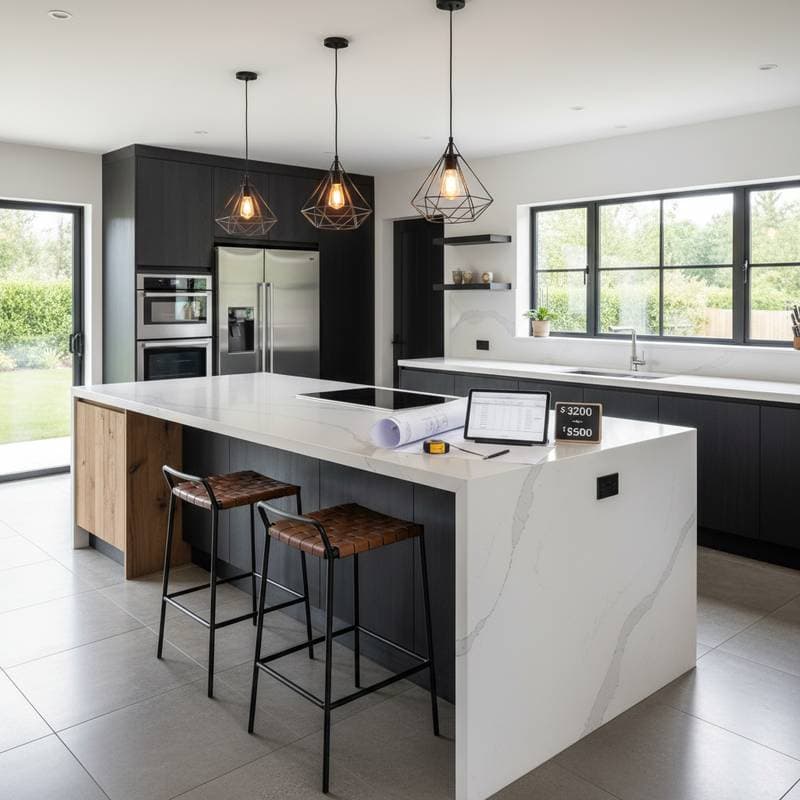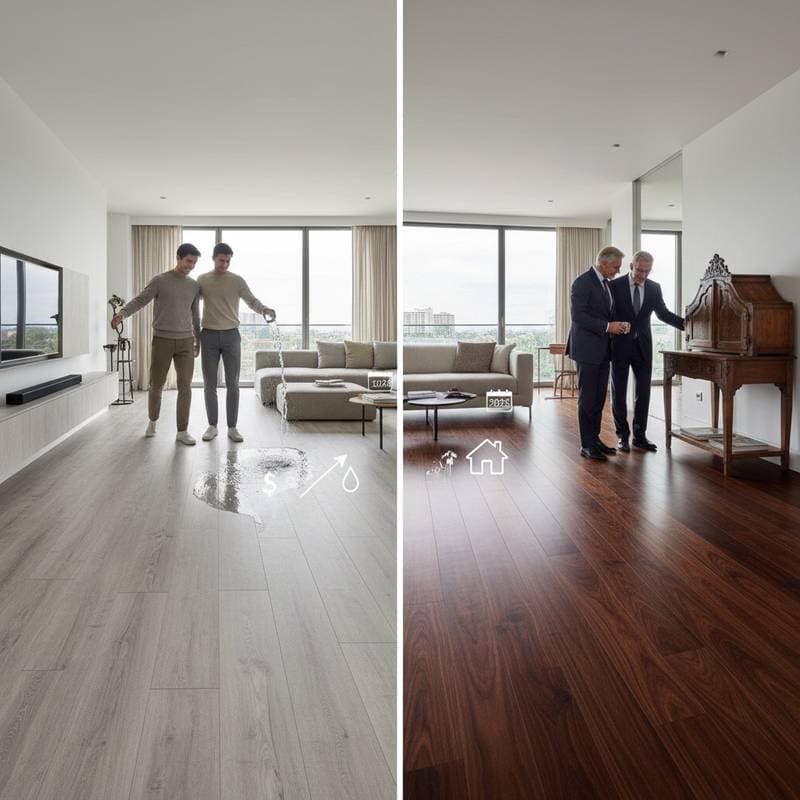Kitchen Island Costs in 2025: A Comprehensive Guide from $3,200 to $9,500
Summary Box
National average cost: $5,800
Typical range: $3,200 to $9,500
Low end and high end: $1,200 for a compact prefab island to $15,000 for an elaborate custom design
Time to complete: 3 to 10 days on site
DIY or Pro: DIY suitable for basic prefab assemblies; professional required for plumbing or electrical components
ROI or resale impact: 60 to 75 percent when integrated into a complete kitchen renovation
Updated: March 2025
Detailed Cost Breakdown
The following table outlines key components of a kitchen island installation. Costs vary based on regional labor rates, material quality, and project specifics. This breakdown provides a clear view of where expenses accumulate.
| Item | Unit Cost | Typical Quantity | Line Total | Notes |
|---|---|---|---|---|
| Base cabinets | $150 to $400 per linear foot | 6 to 10 ft | $900 to $4,000 | Prefab units reduce costs compared to custom millwork |
| Countertop | $40 to $120 per sq ft | 15 to 25 sq ft | $600 to $3,000 | Options include durable granite, sleek quartz, or warm butcher block |
| Electrical work | $75 to $125 per hour | 4 to 8 hrs | $300 to $1,000 | Covers outlets, under-cabinet lighting, and basic wiring |
| Plumbing (if sink added) | $400 to $1,200 flat | 1 | $400 to $1,200 | Encompasses supply lines, drain installation, and connections |
| Flooring patch or extension | $5 to $15 per sq ft | 20 sq ft | $100 to $300 | Essential if the island alters the existing floor layout |
| Finish trim and paint | $2 to $5 per sq ft | 30 sq ft | $60 to $150 | Ensures seamless integration with adjacent cabinetry |
| Labor for assembly and install | $50 to $100 per hr | 10 to 20 hrs | $500 to $2,000 | Involves precise carpentry, alignment, and finishing touches |
| Disposal and permit fees | Flat | — | $100 to $300 | Varies by locality; includes debris removal and regulatory approvals |
Total estimated range: $3,200 to $9,500
Key Factors Influencing Costs
Several elements determine the final price of a kitchen island. Size and scope play a primary role; a modest island accommodating two seats costs considerably less than a expansive, multi-tiered version with ample storage and seating for four or more. Material selections further impact the budget, as high-end finishes like exotic hardwoods or premium stone surfaces elevate expenses beyond basic laminates or composites.
Site-specific challenges also contribute to variability. Kitchens with limited access or irregular flooring demand additional labor for adjustments and reinforcements. Regional differences in labor markets affect rates, with urban areas or peak seasons commanding premiums due to high demand.
Unexpected changes during installation, such as rerouting utilities, can significantly increase costs. Early planning mitigates these risks by identifying potential issues through site surveys and detailed blueprints.
DIY Versus Professional Installation
Homeowners with carpentry experience may tackle simpler projects independently. A capable DIYer assembles and positions prefab or semi-custom kits, applies surface treatments, installs hardware like drawer pulls, and performs basic flooring repairs. These tasks require standard tools and attention to alignment for stability.
Certain elements necessitate professional involvement due to licensing requirements and specialized equipment. Electrical modifications for outlets or integrated lighting demand certified electricians to ensure compliance with safety codes. Similarly, plumbing for sinks, dishwashers, or refrigeration units involves precise pipework that professionals handle to prevent leaks or contamination.
Attempting unlicensed work poses serious risks. Improper wiring leads to fire hazards, while faulty plumbing causes water damage. Inadequate anchoring or sealing on countertops creates instability or moisture intrusion. Adhere strictly to manufacturer guidelines on fasteners, weight limits, and installation sequences.
Professional installations often preserve warranties on cabinets and surfaces, which may lapse with self-installation. Consult product documentation or manufacturers to verify coverage before proceeding independently.
Strategies to Reduce Costs Effectively
Opt for cost-effective alternatives without sacrificing quality. Laminate or solid-surface countertops offer durability at a fraction of quartz prices, while ready-to-assemble cabinets provide customization at lower upfront costs than fully bespoke options.
Prepare the site in advance to streamline the process. Complete flooring updates and utility rough-ins prior to cabinet arrival, minimizing the need for costly adjustments later. Coordinate with contractors during off-peak periods, such as winter months, to secure discounted rates.
Combine the island installation with broader kitchen updates for economies of scale. Bulk purchasing of materials and shared labor across multiple tasks reduce per-unit expenses.
When soliciting bids, prioritize transparency. Insist on itemized scopes detailing materials, brands, preparation work, cleanup, permits, and disposal. Tie payments to project milestones, such as completion of rough-ins or final inspection. Obtain at least three written quotes and check contractor references for reliability.
Step-by-Step Guide for DIY or Hiring
For DIY Projects
Assess your space and select a prefab kit suited to your skill level. Measure the area precisely, accounting for clearances around seating and walkways. Gather essential tools: a cordless drill with driver bits for secure fastening, a level and shims for even placement, a circular saw or jigsaw for custom trim cuts, and safety gear including glasses and gloves.
Begin by preparing the floor, ensuring it supports the island's weight. Assemble the base cabinets according to instructions, securing joints with screws and brackets. Position the unit, anchor it to the floor if required, and install the countertop using adhesive and clamps for a firm bond.
Finish by adding trim, painting to match surroundings, and testing all components for stability. If electrical or plumbing features are absent, the project concludes here. Document the process for warranty purposes.
For Hiring Professionals
Start with a consultation to discuss vision, budget, and timeline. Provide detailed sketches or inspirations, and request a site visit for accurate quoting. Select contractors experienced in kitchen remodels, verifying licenses, insurance, and past portfolios.
Review contracts thoroughly, confirming inclusions like material sourcing and post-installation cleanup. Establish a clear schedule with checkpoints for approvals. Monitor progress to address issues promptly, ensuring the final result aligns with expectations.
Project Timeline and Coordination
Lead times differ by product type. Prefab cabinets typically arrive within two weeks of order, allowing quick starts. Custom fabrications, however, extend to six to eight weeks due to design approvals and manufacturing.
On-site work varies with complexity. Basic prefab installations wrap in one to two days, focusing on assembly and minor adjustments. Elaborate custom projects, incorporating utilities, span up to ten days, including coordination with subcontractors.
Schedule inspections at critical stages. Local authorities often mandate reviews of electrical and plumbing rough-ins before enclosing walls or cabinets. Factor in these pauses to avoid delays in the overall renovation.
Long-Term Maintenance and Durability
Regular upkeep extends the island's life. Wipe surfaces daily with mild, non-abrasive cleaners to prevent buildup, and address spills immediately to protect seals and finishes. Lubricate hinges and tracks quarterly to maintain smooth operation.
Watch for wear indicators like loosening hardware, water damage beneath sinks, or grout deterioration at seams. Minor repairs, such as tightening screws or resealing edges, resolve many issues affordably.
When damage occurs, evaluate options. Refinishing cabinets preserves structural integrity for another decade, while countertop replacement updates aesthetics without full disassembly. Plan for a lifespan of 15 to 25 years with diligent care, maximizing the investment's value.
Maximizing Value in Your Kitchen Remodel
Investing in a kitchen island enhances daily functionality and home appeal. By understanding costs and planning meticulously, homeowners achieve a space that blends style, utility, and efficiency. This addition not only streamlines meal preparation but also boosts property value through thoughtful design choices.



